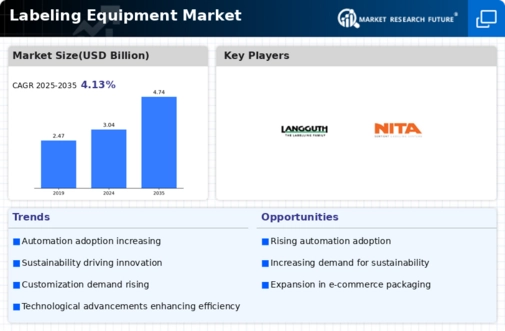Regulatory Compliance
Regulatory compliance plays a crucial role in shaping the Global Labeling Equipment Market Industry. Governments worldwide are implementing stringent labeling regulations to ensure product safety and consumer protection. This necessitates the adoption of advanced labeling technologies that can meet these requirements efficiently. For example, food and beverage industries are increasingly required to provide detailed nutritional information on labels. Consequently, manufacturers are compelled to invest in labeling equipment that adheres to these regulations. This focus on compliance is likely to propel market growth, as businesses prioritize investments in reliable labeling solutions.
Sustainability Trends
Sustainability trends are becoming increasingly prominent within the Global Labeling Equipment Market Industry. As consumers demand environmentally friendly products, manufacturers are seeking labeling solutions that align with sustainable practices. This includes the use of recyclable materials and eco-friendly inks in labeling processes. Companies that adopt sustainable labeling practices may gain a competitive edge, appealing to environmentally conscious consumers. The market's response to these trends could lead to a notable increase in demand for sustainable labeling equipment, potentially influencing overall market growth in the coming years.
Market Growth Projections
The Global Labeling Equipment Market Industry is projected to experience robust growth over the next decade. With a compound annual growth rate (CAGR) of 4.12% anticipated from 2025 to 2035, the market is set to expand significantly. This growth is driven by various factors, including technological advancements, rising e-commerce demand, and increasing regulatory compliance. By 2035, the market is expected to reach 4.74 USD Billion, indicating a strong upward trajectory. These projections highlight the industry's resilience and adaptability in meeting evolving consumer and regulatory demands.
Technological Advancements
The Global Labeling Equipment Market Industry is experiencing a surge in technological advancements, which enhances the efficiency and precision of labeling processes. Innovations such as digital printing technologies and automation are becoming increasingly prevalent. For instance, the integration of IoT in labeling equipment allows for real-time monitoring and data collection, optimizing production lines. This trend is likely to drive the market's growth, as companies seek to improve operational efficiency and reduce costs. As a result, the market is projected to reach 3.04 USD Billion in 2024, reflecting the industry's adaptation to modern technological demands.
Rising Demand in E-commerce
The Global Labeling Equipment Market Industry is significantly influenced by the rising demand in the e-commerce sector. With the exponential growth of online shopping, there is an increasing need for efficient labeling solutions to manage inventory and shipping processes. Companies are investing in advanced labeling equipment to ensure compliance with shipping regulations and enhance brand visibility. This trend is expected to contribute to the market's expansion, as e-commerce sales continue to rise. The anticipated growth trajectory suggests that the market could reach 4.74 USD Billion by 2035, driven by the ongoing evolution of retail and logistics.
Customization and Personalization
Customization and personalization are emerging as key drivers in the Global Labeling Equipment Market Industry. As brands strive to differentiate themselves in a crowded marketplace, the demand for customized labels is on the rise. This trend is particularly evident in sectors such as cosmetics and food, where unique labeling can enhance product appeal. Labeling equipment that offers flexibility in design and production is becoming increasingly sought after. The ability to produce personalized labels in smaller batches is likely to attract businesses looking to cater to specific consumer preferences, thereby fostering market growth.














Leave a Comment